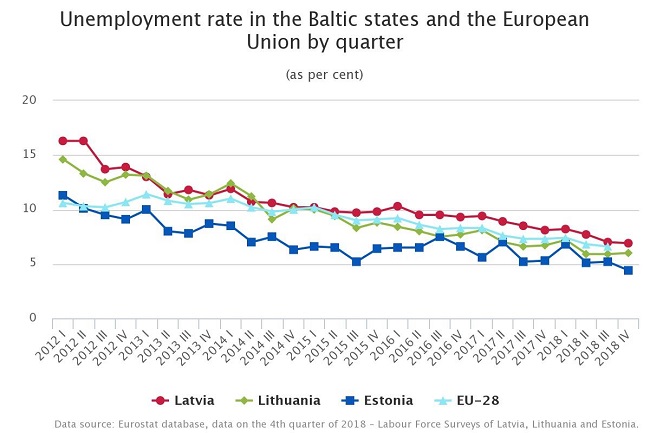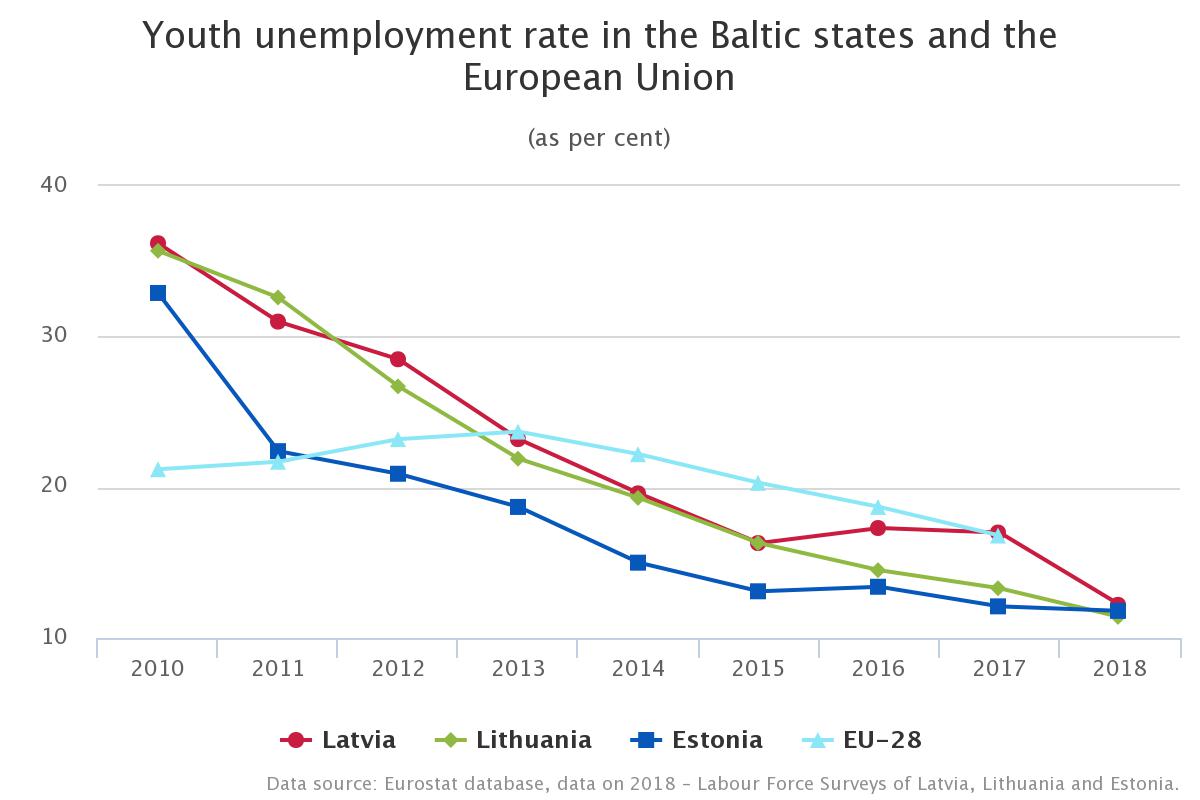Analytics, Employment, Latvia, Statistics
International Internet Magazine. Baltic States news & analytics
Thursday, 25.04.2024, 22:35
In 2018, Latvian unemployment rate constituted 7.4%
 Print version
Print versionCompared to the 3rd quarter, in the 4th quarter of 2018 unemployment rate reduced by 0.1 percentage points and constituted 6.9%. In the 4th quarter, 67.1 thousand people aged 15–74 were unemployed, which is 1.7 thousand or 2.5% less than in the 3rd quarter.
Since the 3rd quarter of 2008, Latvian unemployment rate exceeds the European Union (EU) average (except for the 1st quarter of 2015 when both indicators were equal). In the 3rd quarter of 2018, Latvian unemployment rate (constituting 7.0%) exceeded the EU average (6.6%) by 0.4 percentage points. In the 4th quarter, Latvia still had the highest unemployment rate in the Baltic states (6.9%), compared to 4.4% in Estonia and 6.0% in Lithuania.

Long-term unemployed persons
Over the year, the number of long-term unemployed persons (those who cannot find work for 12 months or more) reduced by 1.8 thousand, and in 2018 it constituted 30.3 thousand persons. As the total number of unemployed persons dropped faster than the number of long-term unemployed persons, the share of long-term unemployed persons in the number of unemployed persons increased by 4.0 percentage points (from 37.7% in 2017 to 41.7% in 2018).
In the 4th quarter, there were 29.1 thousand long-term unemployed persons and in the 3rd quarter – 29.4 thousand. In the 4th quarter, the share of long-term unemployed persons in the total number of unemployed persons constituted 43.4%. Compared to the 3rd quarter, the indicator increased by 0.3 percentage points.
Youth unemployment
In 2018, youth unemployment rate constituted 12.2%, which is 4.8 percentage points lower than a year ago (17.0% in 2017). Out of the total number of unemployed persons, 8.0 thousand or 11.0% were young people aged 15–24. During the year, the number of young unemployed persons fell by 4.1 thousand and their share in the total number of unemployed persons by 3.2 percentage points.
In the 4th quarter, youth unemployment rate constituted 12.0%, which is 1.0 percentage points higher than in the 3rd quarter. The number of young unemployed persons dropped by 0.5 thousand and constituted 7.2 thousand or 10.8 % of the total number of unemployed persons (7.7 thousand or 11.2% in the 3rd quarter).
From 2013 to 2016, Latvian youth unemployment rate was lower than the EU average, however in 2017 it constituted 17.0% and was 0.2 percentage points higher than the EU average (16.8%). In 2018, Latvia still had the highest youth unemployment rate in the Baltic states, compared to 11.4% in Lithuania and 11.8% in Estonia.

In 2018, 37.7% of all young people were active, i.e., employed or actively seeking a job (unemployed), while 62.3% of young people were inactive (mainly studying and not seeking a job). In the 4th quarter, 34.9% of all young people were active, while 65.1% inactive.
Inactive population
In 2018, 30.4% or 428.7 thousand people aged 15–74 (including 157.4 thousand people aged 65–74) were inactive, i.e., were neither employed nor actively seeking a job. Compared to 2017, the number of unemployed persons dropped by 14.4 thousand or 3.2%. In the 4th quarter, 30.6% or 430.4 thousand people aged 15–74 were inactive. Compared to the 3rd quarter, inactive population grew by 9.7 thousand or 2.3%.
In 2018, 13.4 thousand people or 3.1% of the inactive population were discouraged to find a job (18.1 thousand or 4.1% in 2017). In the 4th quarter, this population accounted for 12.2 thousand or 2.8% (17.2 thousand or 4.1% in the 3rd quarter).
In 2018, Labour Force Survey questions about economic activity were asked to 29.1 thousand people aged 15–74 living in 16.3 thousand households, while in the 4th quarter – to 7.4 thousand people aged 15–74 and living in 4.2 thousand households.








 «The Baltic Course» Is Sold and Stays in Business!
«The Baltic Course» Is Sold and Stays in Business!

